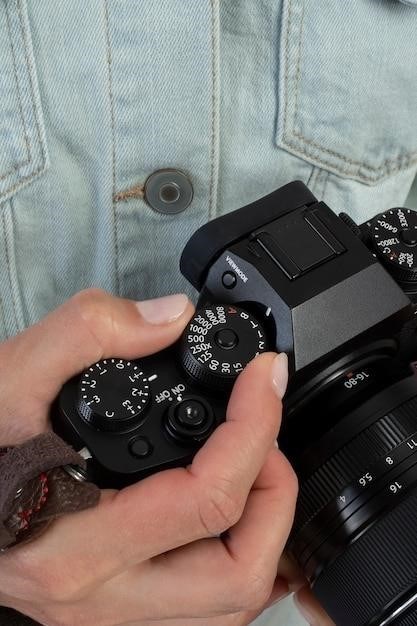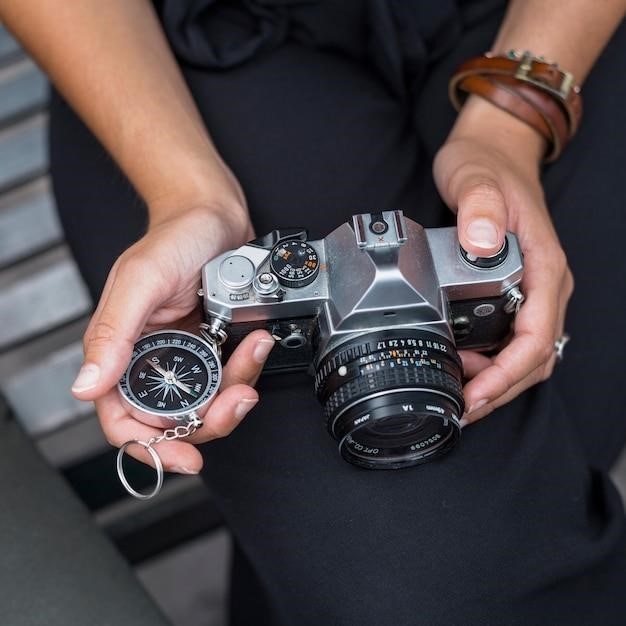Nikon D750 Owner’s Manual⁚ A Comprehensive Guide
This comprehensive guide provides a detailed exploration of the Nikon D750, a powerful full-frame DSLR camera designed for both amateur and professional photographers. It delves into the camera’s key features, user interface, shooting modes, settings, and advanced functionalities, empowering you to capture stunning images and videos with ease. Whether you are a beginner or an experienced photographer, this manual will serve as your ultimate resource for mastering the Nikon D750.
Introduction
The Nikon D750, a celebrated full-frame DSLR camera, stands as a testament to Nikon’s dedication to delivering high-quality imaging solutions for both amateur and professional photographers. Released in 2014, the D750 quickly gained recognition for its impressive blend of features and performance, making it a popular choice among enthusiasts and professionals alike. Its robust construction, advanced image processing capabilities, and versatile shooting modes empower users to capture stunning photographs and videos in a wide range of scenarios.
This manual serves as your comprehensive guide to unlocking the full potential of your Nikon D750. It provides a detailed exploration of the camera’s key features, user interface, shooting modes, settings, and advanced functionalities. Whether you are a beginner taking your first steps into the world of DSLR photography or an experienced photographer looking to expand your creative horizons, this manual will equip you with the knowledge and insights you need to master your D750 and elevate your photographic artistry.

Key Features of the Nikon D750
The Nikon D750 boasts an array of impressive features that make it a versatile and capable photographic tool. At its heart lies a 24.3-megapixel full-frame CMOS sensor, renowned for its exceptional image quality, capturing stunning detail and vibrant colors. The camera’s EXPEED 4 image processing engine ensures fast and efficient processing, enabling you to capture images with remarkable clarity and dynamic range, even in challenging lighting conditions. The D750 also features a robust autofocus system with 51 focus points, including 15 cross-type sensors, providing accurate and reliable focusing for a wide range of subjects.
Further enhancing its versatility is the D750’s ability to record high-quality Full HD videos at 1080p resolution at frame rates up to 30fps, with the option for smooth slow-motion footage at 25fps and 24fps. Its built-in stereo microphones capture clear and natural audio, while the optional external microphone input allows for professional-grade sound recording. The D750 also offers a range of shooting modes, including aperture-priority, shutter-priority, manual, and automatic modes, empowering you to control your exposure and creative settings with precision.
Understanding the Camera’s Interface
The Nikon D750’s user interface is designed to be intuitive and user-friendly, allowing you to navigate the camera’s various settings and functions with ease. The rear LCD screen, with its high resolution and wide viewing angle, provides a clear and detailed view of your images and menus. The camera’s control layout is thoughtfully organized, with dedicated buttons for key functions such as shutter release, aperture control, ISO sensitivity, and exposure compensation. The mode dial, located on the top of the camera, allows you to quickly switch between different shooting modes, including automatic, aperture-priority, shutter-priority, manual, and program modes.
The D750 also features a customizable function button (Fn) that can be assigned to your preferred setting, providing convenient access to frequently used features. The camera’s menu system is well-structured, with clear and concise explanations for each setting. You can navigate through the menus using the multi-selector button, which allows you to scroll through options and make selections. The D750 also offers a dedicated Live View mode, which allows you to compose and focus your shots using the rear LCD screen, providing a more convenient and flexible shooting experience.
Shooting Modes and Settings
The Nikon D750 offers a wide array of shooting modes and settings, providing you with the flexibility to capture a diverse range of photographic subjects and styles. The camera features several automatic modes, including Auto, Scene, and Portrait modes, simplifying the process of capturing well-exposed images with ease. For more control over your creative vision, the D750 offers manual modes, including Aperture-Priority (A), Shutter-Priority (S), and Manual (M) modes, allowing you to adjust the aperture, shutter speed, and ISO sensitivity independently. The camera also offers a Program (P) mode, which automatically selects the best aperture and shutter speed combination for a given scene.
Beyond the basic shooting modes, the D750 provides advanced settings that give you precise control over various aspects of your photography. You can adjust the white balance to accurately represent colors under different lighting conditions. The camera also features a range of Picture Control settings, allowing you to customize the image’s sharpness, contrast, and color saturation to achieve your desired look. The D750’s built-in flash can be used to illuminate subjects in low-light situations, and you can adjust the flash intensity and mode to achieve the desired level of illumination.
Exposure Control and Metering
The Nikon D750 provides a robust system for controlling exposure and metering, enabling you to capture well-exposed images across a wide range of lighting conditions. The camera features a sophisticated metering system that analyzes the scene and determines the optimal exposure settings. You can choose from different metering modes, including matrix, center-weighted, and spot metering, to suit the specific lighting and composition of your shot. The D750’s exposure control system allows you to adjust the aperture, shutter speed, and ISO sensitivity manually or automatically to achieve the desired level of brightness and detail in your images.
The camera’s exposure compensation feature allows you to fine-tune the exposure level by adding or subtracting light from the image. This is particularly useful for adjusting exposure in scenes with high contrast or for creating a specific mood or effect. The Nikon D750 also features a histogram display, which provides a visual representation of the image’s tonal distribution, allowing you to assess the exposure and make adjustments as needed. By mastering the D750’s exposure control and metering system, you can consistently capture well-exposed images with the desired dynamic range and tonal balance.
Focusing and Autofocus
The Nikon D750 boasts an advanced autofocus system that ensures sharp and accurate focus, even in challenging lighting conditions. The camera features a 51-point autofocus system with 15 cross-type sensors, providing comprehensive coverage and precision for a variety of subjects. The autofocus system is sensitive and responsive, accurately locking onto subjects even in low light or with fast-moving action. The D750 offers different autofocus modes, including single-point AF, dynamic-area AF, and 3D-tracking AF, allowing you to select the mode that best suits your shooting needs.
The camera’s autofocus system also incorporates face-detection and eye-detection technologies, enabling you to focus on the eyes of your subjects for stunning portrait photography. The D750’s autofocus system is highly customizable, allowing you to adjust the focus point selection, tracking sensitivity, and other parameters to optimize performance for specific shooting situations. With its advanced autofocus capabilities, the Nikon D750 empowers you to capture sharp and detailed images, whether you’re shooting portraits, landscapes, wildlife, or action scenes.
Image Quality and File Formats
The Nikon D750 delivers exceptional image quality, thanks to its 24.3-megapixel full-frame CMOS sensor and EXPEED 4 image processing engine. The camera captures stunningly detailed images with rich colors, beautiful gradations, and wide dynamic range. The sensor’s sensitivity ranges from ISO 100 to 12800, expandable to ISO 50-51200, allowing you to capture sharp images even in low-light conditions. The D750 produces images with low noise levels, even at high ISO settings, ensuring exceptional clarity and detail.
The D750 offers various image file formats to suit your needs, including JPEG, RAW (NEF), and TIFF. JPEG files are ideal for sharing and online use, while RAW files provide maximum flexibility for post-processing. The camera also supports multiple image sizes and resolutions, enabling you to choose the appropriate settings for your specific requirements. With its impressive image quality and versatile file formats, the Nikon D750 empowers you to capture and create stunning photographs that meet the highest standards of professional photography.
White Balance and Color Management
The Nikon D750 offers a range of white balance settings to ensure accurate color reproduction in various lighting conditions. You can choose from preset white balance options, such as Auto, Incandescent, Fluorescent, Daylight, Cloudy, Shade, and Flash, or manually adjust the white balance using a custom setting. This allows you to achieve natural-looking colors, regardless of the ambient light source. The D750 also features a color management system that enables you to fine-tune the colors and tones of your images.
The camera allows you to adjust the color space, saturation, hue, and sharpness to achieve the desired look and feel. You can also create custom Picture Controls, which are user-defined settings that allow you to personalize your image style. With its advanced white balance and color management features, the D750 empowers you to capture images with accurate and vibrant colors that truly reflect the scene you are photographing. Whether you prefer a neutral, vivid, or monochrome look, the D750 provides the tools to achieve your creative vision.
Customizing Your Nikon D750
The Nikon D750 offers a high degree of customization, allowing you to tailor the camera’s functionality to your specific shooting style and preferences. You can personalize various settings, such as button assignments, menu options, and image parameters, to streamline your workflow and enhance your creative control. The D750’s extensive customization options empower you to optimize the camera for your unique photographic needs.
For example, you can assign frequently used functions to the Fn button, allowing for quick access to essential settings. You can also customize the camera’s menu system, moving frequently used options to the top of the menu list for easy access. The D750 also allows you to create and save custom Picture Controls, enabling you to fine-tune image parameters, such as sharpness, contrast, and color saturation, to match your personal aesthetic preferences. By taking advantage of these customization features, you can personalize the Nikon D750 to become an extension of your photographic vision.
Troubleshooting and Maintenance
While the Nikon D750 is a robust camera, it’s essential to understand common troubleshooting steps and proper maintenance practices to ensure optimal performance and longevity. Should you encounter any issues, consult the Nikon D750 user manual for detailed troubleshooting guides and error codes. For instance, if you experience battery-related problems, the manual might suggest checking the battery contacts, trying a different battery, or resetting the camera.
Beyond troubleshooting, regular maintenance is crucial. Clean the camera’s exterior and lens with a soft, microfiber cloth to remove dust and smudges. Avoid exposing the camera to extreme temperatures, humidity, or direct sunlight for extended periods. When not in use, store the camera in a dry, cool place with a silica gel packet to prevent moisture buildup. Regular cleaning and proper storage will help preserve the camera’s functionality and prevent damage.
Resources and Support
Nikon offers a wealth of resources and support options to help you get the most out of your D750. The official Nikon website provides access to comprehensive user manuals, software updates, and firmware downloads. You can also find troubleshooting guides, frequently asked questions (FAQs), and helpful articles on various photography topics. For more in-depth learning, consider exploring Nikon’s “Learn & Explore” hub, which features articles, tutorials, and educational resources designed to inspire and enhance your photographic skills.
If you need personalized assistance, Nikon’s customer support team is available via phone, email, or online chat. They can help you resolve technical issues, answer questions about camera features, and provide guidance on using the D750 effectively. Additionally, you can connect with other D750 users through online forums and social media groups, where you can share experiences, ask for advice, and learn from the collective knowledge of the community. These resources ensure that you have the support you need to maximize your D750’s potential and capture stunning images.
